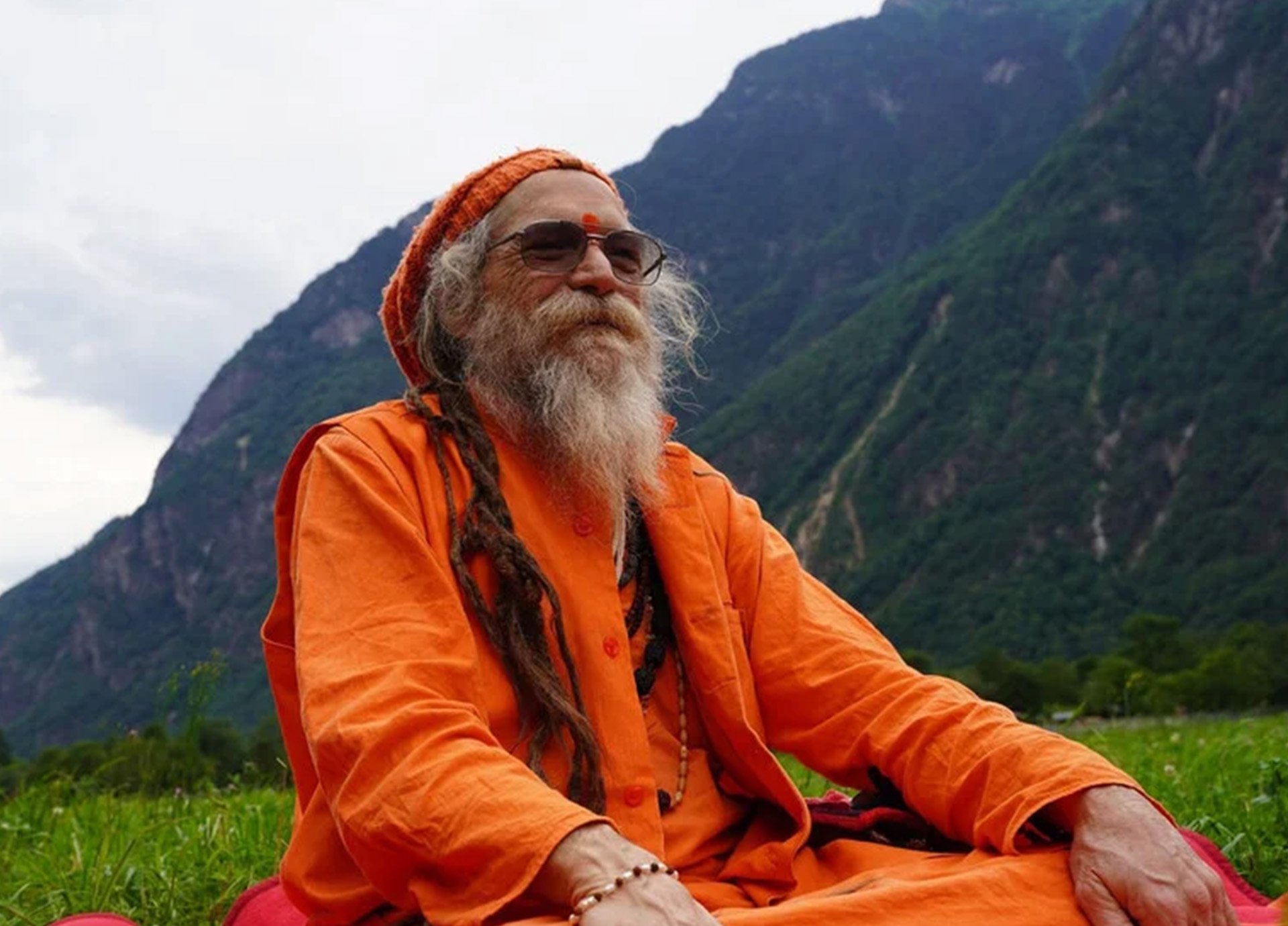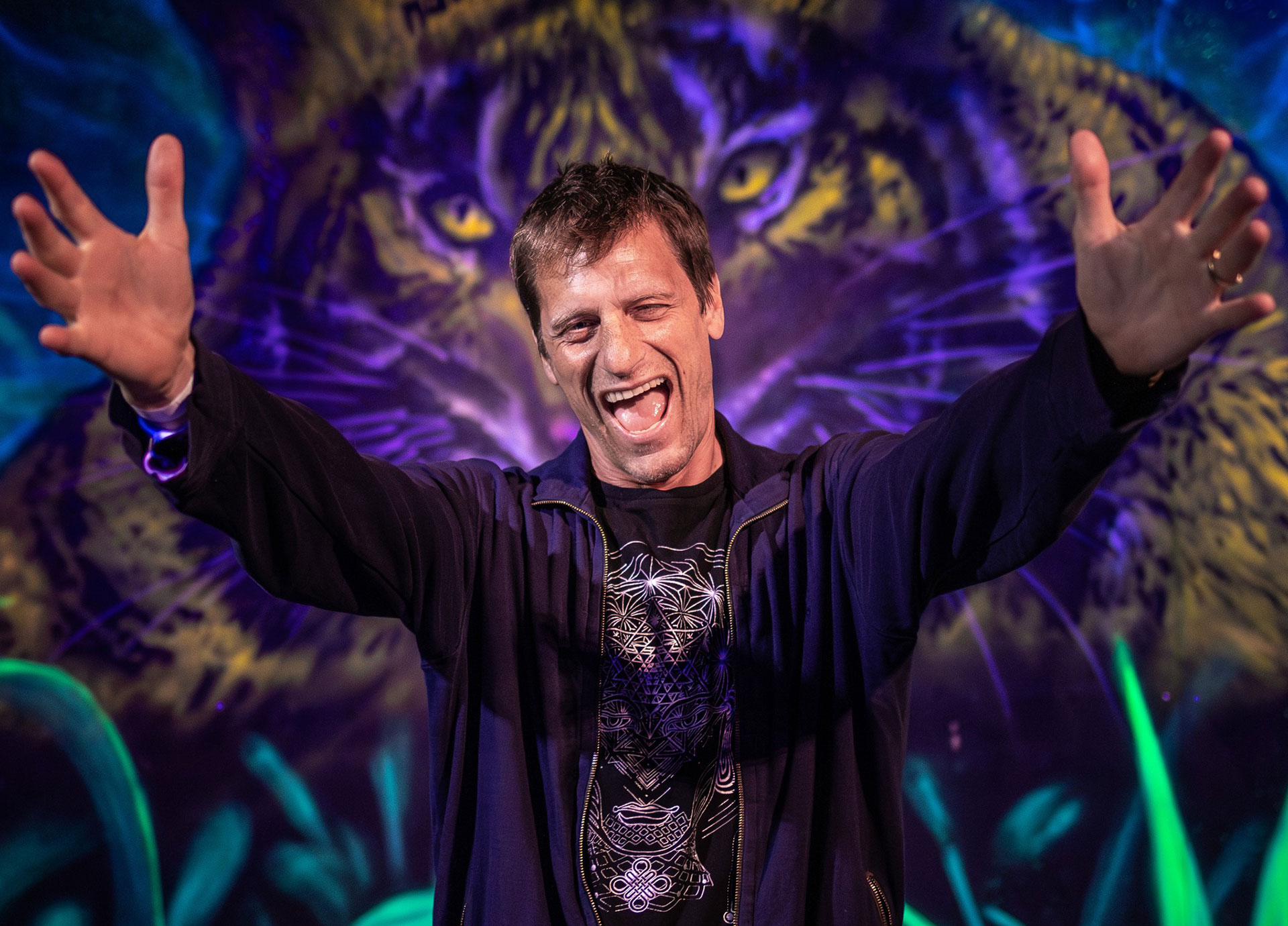
Goa Gil: Pioneering the Spiritual Journey of Psytrance Music
Goa Gil was a historical figure: one of the oldest DJs in the world but also one of the most effective. His specialty: hallucinating twenty-four hours sets, on tape, using hi-tech, dark psy, and all the craziest sounds in psytrance music. The Ozora opening performance on July 30th, this picture probably describes it better than any words.

The artist – who is also a sâdhu (a saint in sanskrit) – dedicated his life to “raising awareness through music”. It is in that quest, between the 70s and the 90s, that he and his companions shaped the spirit of the modern rave in the continuity of the hippy movements. Their model was an inspiration for many, like the Boom Festival, Burning Man, and legions of other ravers around the world. Let’s start smoothly with a seven hours mix recorded in Goa in 2000.

Young Gilbert, ready to go and discover the world
Goa Gil’s story begins in San Fransisco in the 50s but his adventure really starts in 1967. He is 17, his name is Gilbert Levey and he is putting up posters for a living. He does that for a legendary gig in San Fransisco: the Family Dog, where groups such as Santana, Velvet Underground, Jefferson Airplane, or Grateful Dead used to perform. He lives in that 60s/70s rock universe, surrounded by artists like Steve Miller, Jimi Hendrix, the Beatles, or Janis Joplin – “who was a good friend”, amongst many others. “I was in the right place at the right time, as I got to see most of the well-known musical artists of the time performing live, from The Beatles, The Sone, Pink Floyd and Sid Barrett, and on and on and on… All of that is part of my history, and part of who I am. It also helped to shape my musical tastes”.

The Family Dog team, 1968

Gilbert (Goa Gil), 1968
As he narrates his life, Goa Gil presents an imposing flyers collection (in which we found this gem). “Woodstock, the Family Dog, the summer of 1969… It was the psychedelic culture’s golden age in San Fransisco. But the movement was already coming to an end.”
Gil feels that the positive energy that made San Fransisco what it was, is slowly leaving: “All the magic that was there since 1965 met an abrupt end in December 1969.” A few months after the Woodstock climax, a black man dies, stabbed by a Hell’s Angels biker at a Rolling Stones concert in Altamont, this marks the last time of the peaceful atmosphere carefully created by San Fransisco artists.
From San Fransisco to the Indian mountains: the quest for “magic”
It does not take more to Gil to go on his way to find this “magic”. He is 18 when he heads to India, the perfect destination for all the dreamers, pacifists, and all the partygoers of the Western world at the time.
He remembers: “I bought a one-way ticket to Amsterdam then I went through Europe to Morocco, and from there I went across Noth Africa.” From Istanbul, Gil took trains and buses through Turkey, Iran, to end in Afghanistan. “I only paid 30 dollars for the transport, food, and hostels! It was really cheap at that time in 1969.” In Afghanistan, he meets an Englishman who becomes his traveling partner. “He had already been to Goa a year prior to our trip. He told me about the fabulous and deserted beaches… So I decided to accompany him to Goa. We went from Kabul to Karachi and from Karachi we got a boat to Bombay then another to Goa”.

Gil Levey, 1970
Once in Goa, Gil was delighted to meet Eight Finger Eddie, maybe the first-ever Freak in Goa. On Anjuna beach – which was soon to host the Full Moon parties –, he only stays in Eddie’s house “a little house where a crew of Freaks was staying and a few Indians hanging out.” After two weeks, our hero decides to set sail to new destinations, leaving his newfound friends behind in Anjuna.
He hitchhikes and walks down the coast of India and then up the other coast. In Puri, he meets an Aghori Sâdhu who speaks English, and with him, he continues his journey. They go to Calcutta and then to Benares, the holy city in Hinduism. Eventually after visiting Nepal, they go to Kashmir for “Amarnath Yatra”: the pilgrimage to Shiva’s Cave in the high Himalayas.
They stay in Srinagar in a temple full of Babas who are going to Amarnath. The head of the place, Mahant Swami Nirmanaland, gives Gil his first initiations. One of his 5 Gurus is Mahant Primi Giri Ji Maharaj who became his main Guruji after the death of Swami Nirmanaland Ji.

Baba Mangalanand (Goa Gil) celebrating his 19th birthday with some Babas, 1970
_57a0707ba434c.jpg)
Goa Gil and Mahant Prem Giri Ji Maharaj, 1998
The Guru Ji Mahant Guru Ji makes Gil a sâdhu under the name Baba Mangalanand Giri: “With him, I learned everything there is to know about Hindu spirituality and the duties of a sâdhu.” Goa Gil kept a “great discipline” from those years: “Sâdhus make up Shiva’s army, the initiation is far from being easy.”
At the start of 1971, Goa Gil, now named Baba Mangalanand, took part in Khumba Mela – a pilgrimage that gathers several million believers. “There, in our camp at Juna Akhara, I was given further initiations, shaved my head and had a mystical experience that angered me forever”. “After the Kumbh Mela, I went to the Himalayas, to seek out a great Yogi I had head of at the time, to request some teachings.”

Baba Mangalanand (Goa Gil), 1971
At this point, the young American has been traveling the world for two years and has been around wise elderly Hindus for more than one. Nothing matters but spirituality and self-reflection. In December 1971, he receives an aerogram from his old friends asking where he was, telling them they want to see him, asking him to come to Goa. “I decided that I had to go and see them for Christmas.”

Christmas 1971 in Goa, Gil playing guitar down on the right
The revelation
After making his way to Delhi, Mangalanand (aka Gil) makes his way to Goa. “When the universe gives me hints, I try to follow them. I am living my karma… My Destiny if you prefer.” “When I got back to Goa, things had changed! There were more people and small gatherings around bonfires on Anjuna Beach nearly every night. People played drums, flutes, and guitars, and I played too. It was a really powerful experience, as due to my higher meditations in the Himalayas”. Music came through him, giving “blessings” to all who listened: “It was then that I understood the power of music as a tool to transform consciousness and empower people through its Blessings, and even to take the audience to high states of being”.
Music and parties took over the Indian beaches. Tourists came by the dozens to celebrate what Goa Gil calls “The Cosmic Spirit.”

Baba Mangalanand (Goa Gil) in Goa, 1971
Goa, 1974
Around this time, Anjuna Beach was populated by the heirs of the hippy culture, and the young sâdhu had many ideas and projects. What he learned with the Hindus fuses the party culture as Gil realizes “the power of music.” Thereafter he dedicates his life to conveying the teachings he received “using music as a vehicle of transmission”. His goal: “Empowering the youth with a spiritual vision, and thereby making the world a better place.”
In 1974, one of Gil’s musical collaborators of the time, Fantuzzi, and his Butterfly Family published a small booklet of poems, drawings, and son including one from Mangalanand, and gave the credit to Goa Gil. “In those days people hand names like that, there was Amsterdam Dave, Kashmiri Robert, Bombay Brian, etc… And since I was Gil who stayed in Goa, I became known as Goa Gil, and the name stuck! This was long before the techno and trance music started. It was still in the time of acoustic music, even before the parties”.
Gil discovers the transcendental and unifying power of music, he organizes his first parties and settles for the stage name of Goa Gil. He sees music as a way to “go into a trance” and the party as “a suitable vehicle to transmit ideas and knowledge.” Music is not electronic yet but the basis of the rave concept is here.


Goa Gil and his buddies, in the 70s and in the 90s
Throughout the 70s, Goa’s beaches filled up with tourists who ended up settling in. It is the birth of a powerful counter-culture. The ocean, palm trees, Dolce Vita, jam sessions around the fire, beautiful sky, and of course… drugs. Western preoccupations could not be further away.
In Goa, visitors confront their ideas and their creativity in Indian spirituality. Goa Gil is one of the best examples. The party hedonism mixes with piety and spiritual questioning. Psychedelic culture will feed on that mix like nothing before. As of today, Indian culture still has a major role in the psychedelic world. Thanks to Goa, aum, chakra, and karma are now embedded in the ravers’ vocabulary.
 Goa Gil in Bali, 1973
Goa Gil in Bali, 1973
As time passes, Goa’s nightlife constantly grows bigger. Psychedelic rock guitars are slowly replaced by synthesizers, while in the West, electronic music is developing. In 1975, Goa already dances to the sounds of Kraftwerk and Propaganda, “this kind of mainstream music that came to us.”
According to Gil, “Goa turned 100% electronic in the 80s” thanks to newcomers “like the French, DJ Laurent and Suiss DJ Ruedi, who were among the first ones to mix electronic music in Goa”. In his mix, he incorporates dance music and psychedelic rock. The sound may have come from the West but the atmosphere and the inspiration were from nowhere but Goa.
“There were no parties like ours anywhere else in the world Goa Gil remembers as he strokes his endless grey beard. They expressed our ideas and our dreams.” It is the birth of parties with heavy basses, good vibes, dark dancefloors, and fluorescent paint.

Goa Gil, DJ Laurent, and mates during the festivities
Goa becomes a place for experimentation. Ravers tripping their heads off stumble upon monastic Indian sâdhus. The modern rave spirit is being shaped, the one we find today in many events around the world, and that people usually associate with the Spiral Tribe.
Full consciousness, letting yourself go, sharing, free party, self-organization, mutual respect, anti-materialism, all those values come together in Goa and create a ground for a new way of thinking and partying from the meeting between Western tourists and the Indian people. The community gets bigger, and the message improves and spreads: Goa Gil finds the magic.
The Golden age and the birth of Goa’s trance music
“The first tourists were mostly Swiss and French but Christmas 1988 saw the arrival of many tourists from the United Kingdom. I met talented people like Youth and Raja Ram, among others. They had already heard about the parties and me! We welcomed them and they became part of our family discovering our scene, our spirit.”

Ariane (aka. Nimba), Fantuzzi and Raja Ram in Goa, 1989
It is a powerful shock for the musicians who discover what Goa is about musically. They start to produce sounds that fit with this spirit even once they are back in the UK. Transcendence-seeking, tribal inspiration, and dance culture are what they thrive on. Youth gives birth to Dragonfly and Raja Ram to T.I.P Records, Goa Gil humbly says: “I did not create anything on my own, it was them, it as an entire community. We were trying to make the perfect music for Goa’s beaches.”
Their music is derived from EBM and the acid house that started to flourish in the West in the late 80s, rather it has rounder bass lines, faster rhythms, and an obvious preference for mental atmospheres. In addition to the old affection of psychedelic rock for the tribal kick, the folk, and sound.
The first tracks they produce also encapsulate the whole Goa philosophy. They are filled with acoustic sounds or religious atmospheres that echo the community’s values and its quest for transcendence and are edited with effects of every kind. Vocals, prayers, mantras, or philosophical texts will later make their way into trance music.
The early 90s are Goa’s golden age. The atmosphere is “crazy and authentic”. Everyone in Goa is swallowed in a creative and positive spiral, the region becomes a tourist attraction. The deserted place that the young Gilbert found when he first arrived is now a crowded beach that never sleeps.

Partying in Goa, 1991
Eventually, the utopia falls short, magic seems to be so volatile. “When the locals and local authorities understood that there was money to make out of it, they started to monitor Goa’s nightlife, he proceeds with a darker tone. They then created a situation where it was not possible for us to make parties by ourselves, there had to be a local bar owner or some kind of local person involved in taking permissions.” History always repeats itself. On top of that the locals start to be fed up with the permanent “boom boom boom”, and write letters o the newspapers, creating a kind of hysteria with a section of the local Catholic population about the evils of these “Hippie Full Moon Parties”.
In the 2000s, Goa almost became a first-class tourist destination. Partygoers came from all around the world to get smashed in what almost looked like conventional parties. The hippy aesthetic is still there but the spirit is slowly dying as the early bohemians of Goa start to make their way home. The government’s intervention might be questionable but it made Goa the first state on GDP per inhabitant in India.

Goa, 1991
The spirit and the atmosphere are not completely dead though, and it still influences electronic music and the rave culture. Ibiza is a good example but Burning Man, the freetekno movement, and most of the trance festivals are also on the list. None of the above mentioned can ignore its affiliation to the Goa years and Goa Gil and his friends.
Ariane and Goa Gil the DJ
Goa Gil wears many different hats. Artist, priest, event organizer, philosopher… But it is his DJ sets that made him famous. He has always pushed back the limits with ever longer sets. 12, 24 hours, sometimes even more. And everything is on tape! But none of that would have been possible without meeting Arian McAvoy a.k.a. Nimba.
The young French woman becomes his partner in music and she will never leave his surroundings. Their psychedelic all-night longs sets were not nights to be missed. Together they create the duo The Nommos which has left a burning mark on the psychedelic culture.

Ariane and Goa Gil, 1987
Ariane, Goa Gil and Albert Hoffman (who discovered LSD) partying.
About his sets, Gil explains: “Playing music is my way to worship the Universe and the Cosmic Spirit. I set up my puja, say my Mantras, plug in my hardware and the Ritual starts”
“Mixing all night long is what I do and what I have always done.” Therefore he rarely will ever appear on any line-up. He prefers to play along, with Ariane, and that way he “can take the crowd on a mystical musical journey and bring them to where music and dance meet Divinity..”
How is that possible at this age? We can already hear the scandalmongers and their rumors, but Goa Gil is not the kind of guy to chemically boost himself up. “By the Blessings of Guru Maharaja, I have become the man I am today, and is through his Blessings that all of this is possible!”
“Har Har Mahadev! Jai Ma! Jai GuruDev! Om Namah Shivaya! Om Namo Narayan”, he repeated.
“In the spiritual path, nothing is possible without self-surrender. In that spirit, I have become a servant of the Divine. I do not work for myself but for the greater good of the Universe and Life itself. If there is something in front of me, that the Universe shows me that needs to be done, I do it without question! It is my Duty”.
Modern views
Today, Goa Gil still regularly tours around the world. Brazil, Japan, California, South Africa, and a few festival appearances… His schedule is quite busy but he still finds time to rest in India for a few months every year. “India is my spiritual home and my spiritual family is there”.
He does not endorse all the evolutions of the trance scene but he assures that he does not play “tracks older than a year.” He receives the tunes he plays from the artists and labels he has been working with for a long time, and of course, the many artists who also send him tracks with hopes that he will play them in his sets. “There are so many good producers these days, amongst my favorites are Sectio Aurea, Dark Whisper, Dog of Tears, and Fractal Cowboys.” If there is no Ace Ventura or Ajja on that inventory, it is because Goa Gil belongs to another strand of trance music: “I do not have time to listen to what everyone is doing these days. I have listened to many kinds of techno and trance music during the last many years and what I play now is the new evolution of all of that, the way I see it.”
Clearly darker and harder to get into, Goa Gil’s music is meant to capture minds and bodies in a storm of effect, frantic rhythms, and psychedelic noises. The artist sees dance as a form of “active meditation”. With high BPMs and captivating sounds, Goa Gil tries to generate intense sensations in the public.
Goa Gil is the perfect answer to those who try to demonize ravers and their spirits. He is not only the spiritual father of the latter he is also a priest. This unexpected combination shows how virtuous the rave movement is and its profoundly pure and generous intentions. The man, who never saw DJing as just playing records, has now a fatherly view on ravers all over the world. “The spiritual part is primordial in the rave, he says with a caring and positive stare. The music must allow for inner development not become a business object.”
When asked about the party’s bad sides he replies: “People evolve at their own pace; we all live our karma and you need to start somewhere. I can only hope that people are on the right path and that rave has not evolved to a simple concept of people just taking drugs.” Before concluding: “The point is to learn to control yourself, to do your best, and convert negative situations into positive energy.”
Before concluding: “The Art of Living is to be like the Alchemist. Just like he transforms lead into gold, we must learn to transform all negative situations into positive situations to make the world a better place.
Since the beginning of time, mankind used music and dance to commune with nature and the Spirit of the Universe. We are using trance music and the trance dance experience to set off a chain reaction in consciousness. This is what we call: “Redefining the ancient tribal ritual for the 21st century. dance is active meditation. When we dance we go beyond thought, beyond mind, and beyond our own individuality. This is the essence of the trance dance experience.” ![]()
The article was first published at www.traxmag.com
Subscribe To Our Magazine!
Get every issue of Psychedelic Magazine delivered straight to your inbox every month - for free! We do not spam!
You have subscribed successfully!
Some error occured
Please fill all the required * fields.








